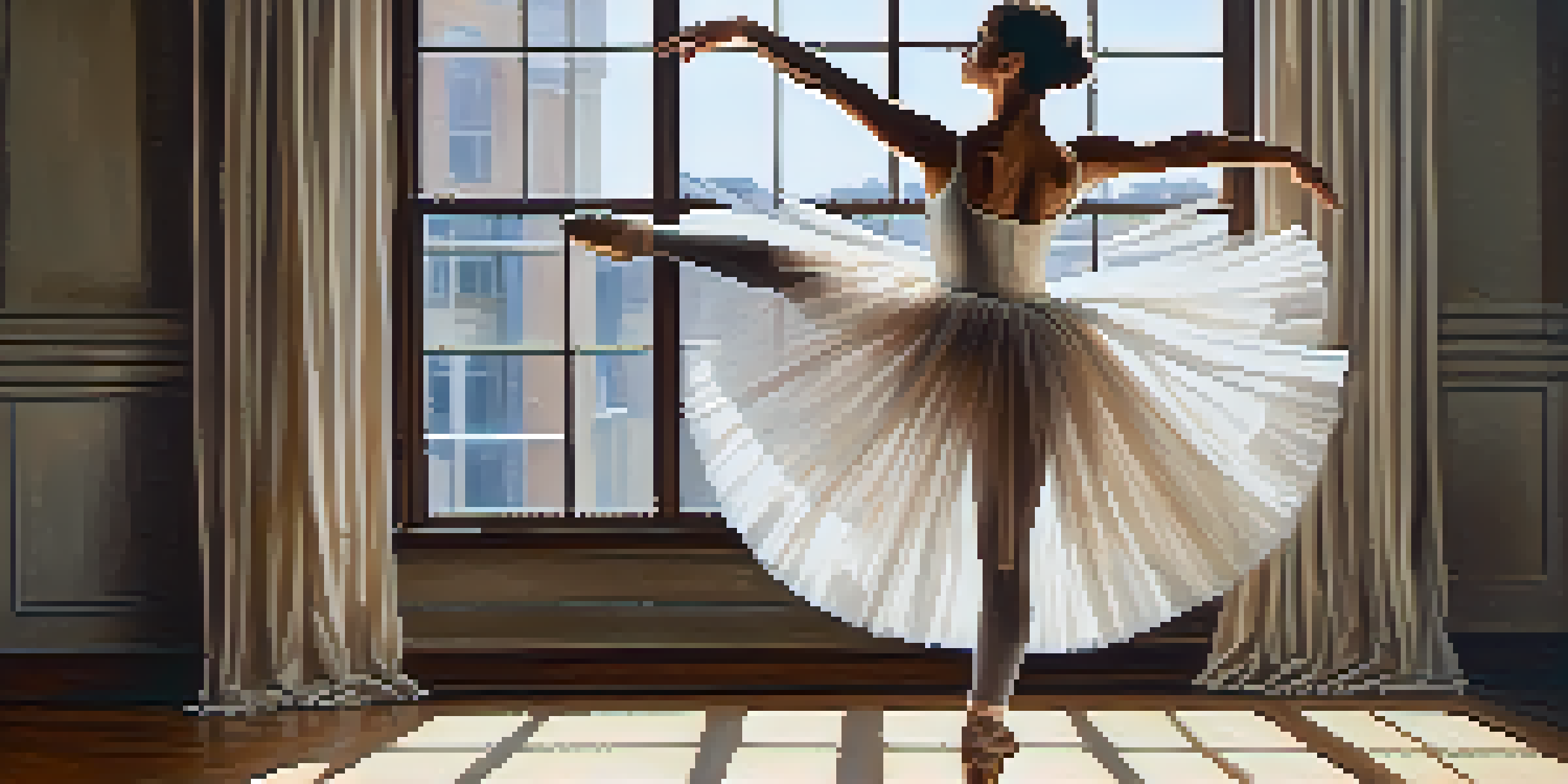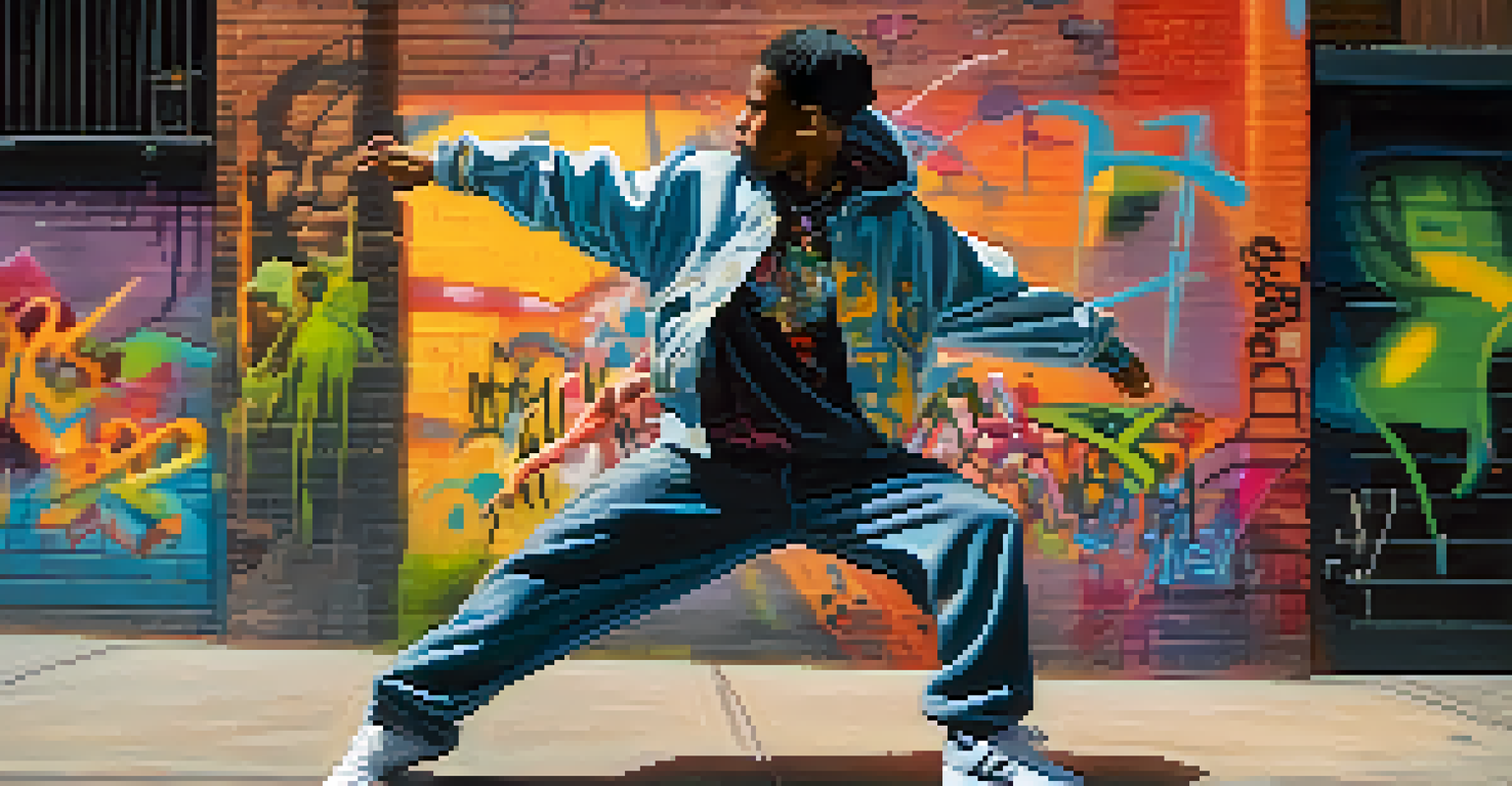Understanding Body Awareness Through Different Dance Styles

What is Body Awareness and Why It Matters
Body awareness refers to the understanding of where your body is in space and how it moves. This concept is essential not just in dance, but in everyday life, as it enhances coordination and reduces the risk of injury. When you are aware of your body's movements, you can express emotions and ideas more effectively through dance.
Dance is the hidden language of the soul.
In dance, body awareness allows dancers to connect with their movements and the music, creating a harmonious blend of rhythm and emotion. For instance, a ballet dancer must be acutely aware of their posture and alignment to execute movements gracefully. This kind of awareness also fosters confidence, making it easier to explore more complex dance styles.
Ultimately, developing body awareness enhances your overall physicality and helps you become more in tune with your body's capabilities. This journey often begins with experimenting with various dance styles, each offering unique ways to connect with your body.
Ballet: Precision and Posture
Ballet is often considered the foundation of many dance styles, emphasizing precision and posture. Dancers must develop a strong sense of body awareness to maintain balance while executing intricate movements. The discipline required in ballet helps dancers cultivate a deep understanding of their body mechanics, making it easier to control their movements.

Through ballet training, dancers learn the significance of alignment, which helps prevent injuries and improves overall performance. For example, the concept of 'turnout' in ballet requires dancers to rotate their hips while maintaining stability, a skill that enhances body awareness. As they practice, they become more attuned to how their body interacts with gravity and space.
Body Awareness Enhances Dance Skills
Developing body awareness is crucial for dancers, as it improves coordination, reduces injury risks, and enhances emotional expression.
This heightened awareness gained from ballet can influence other dance styles. A dancer who understands their posture and balance in ballet will find it easier to adapt to jazz or contemporary dance, translating their skills into a versatile movement vocabulary.
Hip-Hop: Rhythm and Expression
Hip-hop dance is all about rhythm and personal expression, requiring dancers to be highly aware of their body’s movements in relation to the beat. Unlike the structured nature of ballet, hip-hop encourages individual style, allowing dancers to interpret music in their own unique way. This fosters a different kind of body awareness, rooted in spontaneity and creativity.
To watch us dance is to hear our hearts speak.
When dancing hip-hop, the focus shifts from rigid posture to fluidity and rhythm. Dancers learn to isolate different body parts, like the shoulders or hips, creating dynamic and powerful movements. This focus encourages a greater connection with the music and a deeper understanding of how to move with confidence.
As dancers develop their hip-hop skills, they enhance their body awareness in a way that's both fun and liberating. The ability to express oneself through movement helps build self-esteem and encourages exploration, making dance a joyful experience.
Contemporary Dance: Fluidity and Emotion
Contemporary dance merges various styles, focusing on fluidity and emotional expression. Dancers often explore how their bodies can convey complex feelings, which requires a heightened sense of body awareness. This style encourages exploration of movement quality and dynamics, allowing dancers to connect deeply with their emotions and physicality.
Through contemporary dance, practitioners learn to let go of rigid techniques, embracing improvisation and personal interpretation. This freedom fosters a sense of awareness that encourages them to listen to their bodies and express themselves authentically. Dancers often describe this experience as liberating, as it breaks the mold of traditional techniques.
Different Styles Foster Unique Awareness
Each dance style, from ballet to hip-hop, offers distinct ways to enhance body awareness, allowing dancers to connect more deeply with their movements.
The emotional connection fostered in contemporary dance can lead to a profound understanding of one's body. This awareness not only translates into stronger performances but also enhances personal growth and self-discovery.
Jazz Dance: Energy and Connection
Jazz dance is characterized by its energetic movements and improvisational elements, requiring dancers to have strong body awareness. The upbeat tempo of jazz music invites dancers to engage with rhythm and syncopation, promoting a lively and expressive style. This immersion in music and movement encourages dancers to become more aware of their body's responses.
In jazz, dancers often use body isolations—moving one body part independently from others. This practice enhances their understanding of body mechanics and coordination, making them more versatile dancers. The ability to execute sharp and fluid movements develops through consistent practice and a keen awareness of their physical capabilities.
As dancers become more attuned to their body in jazz, they also learn to connect with their audience. This emotional connection adds depth to their performances, allowing them to convey stories and feelings through their movements.
Latin Dance: Rhythm and Social Interaction
Latin dance styles, such as salsa and cha-cha, emphasize rhythm and social interaction, highlighting the importance of body awareness in a partner context. In these dances, being aware of your own movements while simultaneously responding to a partner's cues is essential. This dynamic interaction fosters a unique connection that enhances body awareness on multiple levels.
The close physical connection in Latin dance requires dancers to be in tune not only with their own movements but also with their partners. This awareness allows for seamless transitions, making the dance feel fluid and cohesive. Additionally, the rhythmic patterns in Latin music help dancers develop a strong sense of timing and spatial awareness.
Dance as a Tool for Personal Growth
Engaging in various dance styles not only improves physical abilities but also fosters emotional connections and boosts self-confidence.
By engaging in Latin dance, individuals can enhance their social skills while cultivating a deeper understanding of their own bodies. This combination of body awareness and social interaction creates a joyful and enriching dance experience.
Tap Dance: Sound and Body Rhythm
Tap dance uniquely combines rhythm and movement, as dancers create sounds with their feet. This distinctive quality requires a profound sense of body awareness, as tap dancers must coordinate intricate footwork while maintaining upper body control. The connection between sound and movement enhances the overall dance experience, fostering a joyful exploration of rhythm.
As tap dancers hone their skills, they develop an acute awareness of timing and musicality. The emphasis on footwork allows them to listen closely to their own movements and the music, creating a dialogue between their body and sound. This heightened awareness translates into a deeper understanding of rhythm and beats.

Ultimately, tap dance encourages an appreciation of the body's ability to create music, blending movement and sound in a unique way. This connection enriches the dancer's experience, making body awareness an integral part of their artistic expression.
Conclusion: The Journey of Body Awareness in Dance
Exploring different dance styles offers a rich journey toward enhanced body awareness. Each style presents unique challenges and opportunities, allowing dancers to connect with their bodies in diverse ways. Whether it's through the precision of ballet, the freedom of hip-hop, or the rhythm of tap dance, each experience contributes to a dancer's growth.
As individuals engage with various forms of dance, they not only improve their physical skills but also foster emotional and social connections. The process of becoming more body-aware can boost confidence, creativity, and self-expression. Dance becomes a powerful tool for personal development and exploration.
In the end, the beauty of dance lies in its ability to unite body and mind, facilitating a deeper understanding of oneself. By embracing the journey of body awareness through different dance styles, individuals can unlock their full potential as dancers and as expressive beings.